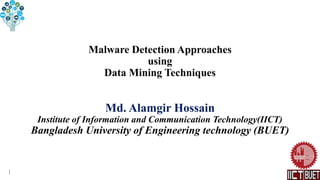
Malware Detection Approaches using Data Mining Techniques.pptx
- 1. Malware Detection Approaches using Data Mining Techniques Md. Alamgir Hossain Institute of Information and Communication Technology(IICT) Bangladesh University of Engineering technology (BUET) 1
- 2. Contents Definition of Malware Concept of Data Mining Malware Detection Approaches in Data Mining Signature-Based Approach Behavior-Based Approach Challenges to Detect Malware for the Digital World Suggestions about Malware Detection for Future Conclusion References 2
- 3. Malware Malware, or malicious software, is any program or file that is intentionally harmful to a computer, network or server. Malware can be different types like Viruses, Worms, Trojan Horses, Ransomware, and Spyware. These malicious programs steal, encrypt and delete sensitive data; alter or hijacking core computing functions and monitor end user’s computer activity. Malware can infect networks and devices and is designed to harm those devices, networks and/or their users in some way. 3
- 4. Data Mining Data mining, also called knowledge discovery in database (KDD), is the nontrivial extraction of implicit, previously unknown, and potentially useful information (Meaningful Patterns) from data in large data repositories/database. Knowledge Discovering Process: 4
- 5. Malware Detection Approach (Signature-Based) Signature-based system finds malware using a predefined list that is called predefined database. Malicious objects have characteristics that can be used to generate a unique digital signature. The database sources include huge number of the various signatures that classify malicious objects. Assembly and binary feature extractions are two main methods of this approach. It is less effective for the quickly changing nature of portable malware or the variations of known malware. 5
- 6. Malware Detection Approach (Signature-Based) 6 Figure: Signature-Based Approach to Detect Malware
- 7. Advantages & Weakness of Signature-Based Detection Advantages: Easy to run Fast Identification Broadly accessible Finding comprehensive malware information Weakness: Failing to detect the polymorphic malwares Replicating information in the huge database 7
- 8. Malware Detection Approach (Behavior-Based) It reviews the selected behavior to detect the malware. It gives a superior comprehension of how malware in produced and implemented. Malicious behavior is known using a dynamic analysis that evaluates malicious intent by the object’s code and structure. API calls and assembly features are two main methods of this approach. 8
- 9. Malware Detection Approach (Behavior-Based) 9 Figure: Behavior-Based Approach to Detect Malware
- 10. Advantages & Weakness of Behavior-Based Detection Advantages: Detecting unconceived types of malware attacks Data-flow dependency detector Detecting the polymorphic malwares Weakness: Storage complexity for behavioral patterns Time complexity 10
- 11. Challenges to Detect Malware for the Digital World Encryption and Decryption Detection Meta-Heuristic Detection Real-Time Malware Detection Etc. 11
- 12. Suggestions about Malware Detection for Future Malware detection in the new platform and architecture like Internet of Things (IoT) applications, E-Banking, and Social Networks etc. Improving the malware detection for predicting the polymorphism attacks. Context-Aware detection can be the new idea for dynamic malware detection approaches. Providing a safe condition (security) for Big Data against the malware attack. Etc. 12
- 13. Conclusion Both are proposed for windows, and smartphones platform and Embedded System. Uses Static, Dynamic and Hybrid data analysis methods. DBScan (Hybrid Pattern Based Text Mining Approach) is the best method on respect of accuracy in signature-based approach by using ANN, Malicious Sequential Pattern Based Malware Detection classification techniques. CloudIntell (Feature Extraction in Cloud) is the best method on respect of accuracy in behavior-based approach by using SVM, Decision Tree, Static Boosting classification technique. Meta heuristic algorithms can speed up and improve the execution time and overall accuracy. 13
- 14. References [1] Souri A, Hosseini R (2018) A state-of-the-art survey of malware detection approaches using data mining techniques. Human-centric Computing and Information Sciences 8:1-22. [2] Fraley JB, Figueroa M(2016) Polymorphic malware detection using topological feature extraction with data mining. SoutheastCon 2016, pp 1-7. [3] Malhotra A, Bajaj K (2016) A hybrid pattern-based text mining approach for malware detection using DBScan. Trans ICT 4:141–149. [4] Boujnouni ME, Jedra M, Zahid N (2015) New malware detection framework based on N-grams and support vector domain description. In: 2015 11th international conference on information assurance and security (IAS), pp 123–128. 14
- 15. References [5] Wang P, Wang Y-S (2015) Malware behavioral detection and vaccine development by using a support vector model classifier. Journal of Computer and System Sciences 81:1012–1026. [6] Sun H, Wang X, Buyya R, Su J (2017) CloudEyes: cloud-based malware detection with reversible sketch for resourceconstrained internet of things (IoT) devices. Software—Practice & Experience 47:421–441. [7] Tang Y, Xiao B, Lu X (2011) Signature tree generation for polymorphic worms. IEEE Transactions on Computers 60:565–579. [8] Palumbo P, Sayfullina L, Komashinskiy D, Eirola E, Karhunen J (2017) A pragmatic android malware detection procedure. Computers and Security 70:689– 701. 15
- 16. Thank You
